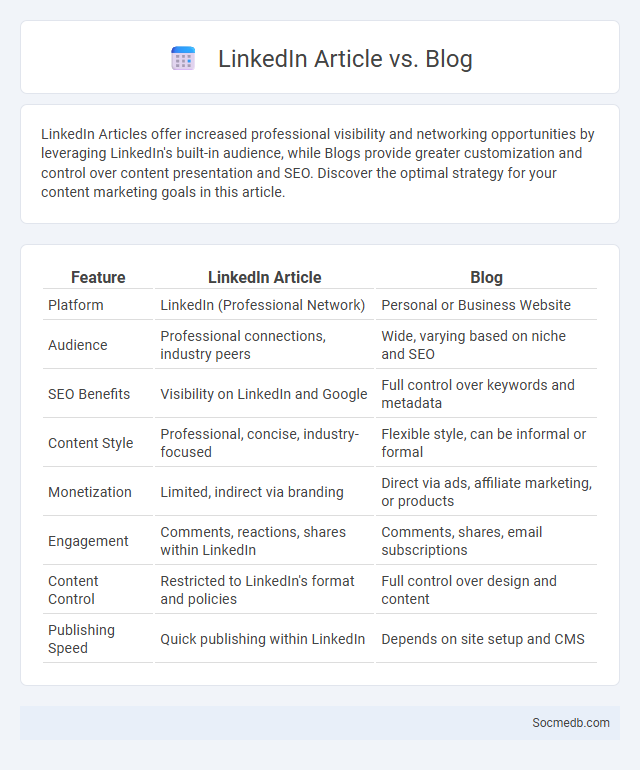
Photo illustration: LinkedIn Article vs Blog
LinkedIn Articles offer increased professional visibility and networking opportunities by leveraging LinkedIn's built-in audience, while Blogs provide greater customization and control over content presentation and SEO. Discover the optimal strategy for your content marketing goals in this article.
Table of Comparison
| Feature | LinkedIn Article | Blog |
|---|---|---|
| Platform | LinkedIn (Professional Network) | Personal or Business Website |
| Audience | Professional connections, industry peers | Wide, varying based on niche and SEO |
| SEO Benefits | Visibility on LinkedIn and Google | Full control over keywords and metadata |
| Content Style | Professional, concise, industry-focused | Flexible style, can be informal or formal |
| Monetization | Limited, indirect via branding | Direct via ads, affiliate marketing, or products |
| Engagement | Comments, reactions, shares within LinkedIn | Comments, shares, email subscriptions |
| Content Control | Restricted to LinkedIn's format and policies | Full control over design and content |
| Publishing Speed | Quick publishing within LinkedIn | Depends on site setup and CMS |
Introduction to Content Platforms
Content platforms like Instagram, TikTok, and YouTube revolutionize how Your message reaches diverse audiences by leveraging multimedia formats such as video, images, and interactive posts. These platforms employ algorithms that optimize content visibility based on user engagement, enhancing content discovery and audience targeting. Mastering these tools enables creators and businesses to boost brand awareness, increase follower interaction, and drive targeted traffic effectively.
Defining LinkedIn Articles
LinkedIn Articles are long-form content published directly on the LinkedIn platform, designed to showcase expertise and thought leadership. These articles allow users to share in-depth insights, industry trends, and professional experiences with their network and beyond. Optimizing LinkedIn Articles with relevant keywords and engaging headlines increases visibility and drives meaningful audience engagement.
What is a Blog Post?
A blog post is a digital article or entry published on a website, often used to share information, opinions, or updates on specific topics. It typically includes text, images, videos, and links to enhance user engagement and search engine optimization (SEO). Effective blog posts are structured with headings, keywords, and meta descriptions to improve visibility on social media platforms and search engines.
Understanding Traditional Articles
Traditional articles on social media platforms provide in-depth analysis and well-researched content that offers valuable insights into trends and user behavior. These articles often incorporate expert opinions, statistics, and case studies to enhance your comprehension of social dynamics and marketing strategies. Engaging with such content helps you make informed decisions and optimize your social media presence effectively.
Key Audience Differences
Understanding key audience differences across social media platforms is vital for crafting tailored content that maximizes engagement and conversion. For example, Instagram's youthful demographic favors visually appealing posts and stories, while LinkedIn appeals to professionals seeking industry insights and networking opportunities. By analyzing these distinctions, you can optimize your messaging to resonate effectively with your target audience on each platform.
Content Style and Tone Comparison
Social media content style varies significantly across platforms, with Instagram favoring visually-driven, casual posts, while LinkedIn emphasizes professional, informative messaging tailored to business audiences. Your tone should adapt accordingly, maintaining a friendly and engaging voice on Facebook and Twitter, contrasted with a more formal and authoritative style on platforms like LinkedIn. Understanding these nuances enhances audience connection and boosts engagement rates.
SEO and Visibility Factors
Optimizing social media profiles with relevant keywords enhances your SEO by increasing search engine visibility and driving organic traffic. Regularly posting high-quality, engaging content aligned with trending topics and hashtags boosts audience interaction and improves your social media rankings. You should also leverage backlinks from social platforms to your website to strengthen domain authority and overall search performance.
Engagement and Networking Opportunities
Social media platforms offer unparalleled engagement opportunities, enabling you to connect with targeted audiences through interactive content such as polls, live videos, and comment threads. These networks facilitate meaningful interactions that foster community-building and brand loyalty, enhancing your overall online presence. Leveraging these tools effectively can expand your professional and social networks, driving both visibility and growth.
Best Use Cases for Each Format
Video content on social media excels in storytelling and product demonstrations, capturing audience attention through dynamic visuals and sound. Carousel posts are ideal for showcasing multiple products or features in one post, enhancing user engagement through swipeable content. Your brand can leverage live streams to build real-time interaction and trust, fostering a loyal community around authentic experiences.
Conclusion: Choosing the Right Platform
Selecting the right social media platform depends on your target audience, content type, and marketing goals to maximize engagement and reach. Platforms like Instagram excel for visually-driven brands, while LinkedIn is ideal for B2B networking and professional growth. Tailoring your strategy ensures your message resonates effectively with your audience and drives meaningful results.
 socmedb.com
socmedb.com